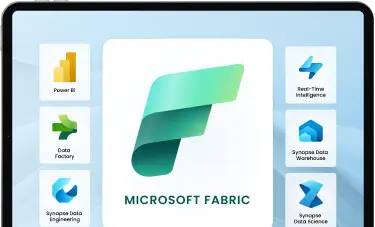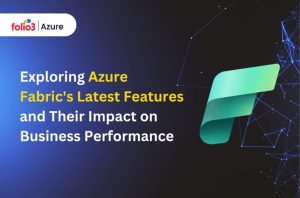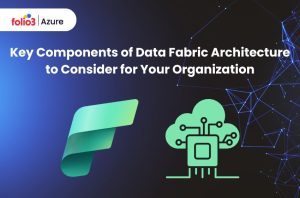Table of Contents
ToggleData is the lifeblood of every successful business today. Now, there must be a few questions in your mind: First of all, how is the data used? How does it derive success? Well, welcome to the world of data analytics! Until you make the most of your data, it’s useless.
Hence, to make the data meaningful, helpful, and beneficial, you need to transform it into information; you need a solid platform to help you! This is why the choice of platform matters the most, as it is directly proportional to your business success.
With the exponential growth of data, enterprises are searching for tools that can provide analysis and insights that positively impact business decisions. Two pioneering analytics platforms are Microsoft Fabric and DataBricks.
In this article guide, we’ll explore more about them and discuss their capabilities and shortcomings to help you select the best one for the analytics landscape in 2024.
Microsoft Fabric
Formerly known as Common Data Fabric, Microsoft Fabric is a modern, flexible suite of data management and insights tools. It is designed to provide a user-friendly environment with powerful data processing capabilities that integrate seamlessly with Microsoft’s broader cloud infrastructure.
Pros of Microsoft Fabric
- Enhanced Collaboration: Microsoft Fabric streamlines teamwork with integrated tools for more efficient communication and project management.
- Scalability: Easily scales with your business, accommodating growth without sacrificing performance.
- Robust Security: Offers top-tier security features to protect your data and ensure compliance with industry standards.
- Seamless Integration: Works seamlessly with other Microsoft products, enhancing productivity and user experience.
- Innovative Features: Continuously updated with the latest technological advancements to keep your business at the forefront.
Cons of Microsoft Fabric
- Limited Compatibility: Fabric incorporates data from many different sources within and outside the Microsoft ecosystem. Its capabilities are limited compared to the options available in Azure services, as Fabric was released recently and still has more features being added. This could be a drawback for organizations with diverse technology stacks.
- Customization Challenges: Although Microsoft Fabric provides a set of pre-designed components and styles, extensive customization beyond these defaults can be challenging. Customizing components or styles outside the provided framework may require significant effort and workaround solutions such as Azure Functions.
- Cost and Complexity: Although Microsoft Fabric is an all-encompassing data platform, its complexity and wide range of features can hinder its implementation for small—to mid-sized businesses. In addition, the cost of implementing and managing the platform can be a burden due to their limited budgets.
Accelerate smart decisions with Microsoft Fabric's unified data and AI analytics.

Databricks
DataBricks, by contrast, is a unified data analytics platform designed by the creators of Apache Spark. It’s an open-source, cloud-based platform that aims to simplify the complexities of big data and machine learning within one environment.
Pros of DataBricks
- Unified Platform: Databricks provides a unified platform for data engineering, data science, and collaborative data analysis. It seamlessly integrates with various data sources and tools, reducing the need for multiple disjointed systems.
- Scalability: Leveraging Apache Spark’s distributed computing power, Databricks offers scalability to handle large-scale data processing and analytics tasks. It can quickly scale up or down based on workload demands.
- Performance: Databricks optimizes Spark clusters for performance, enabling faster data processing and analytics. It leverages in-memory computing and parallel processing capabilities to achieve high performance even with massive datasets.
- Collaboration: Databricks facilitates collaboration among data teams with features like shared notebooks, version control, and real-time collaboration. This fosters teamwork, knowledge sharing, and faster iteration cycles in data-driven projects.
Cons of DataBricks
- Cost: While Databricks offers a range of pricing options, including pay-as-you-go and subscription plans, it can be costly, especially for organizations with large-scale data processing needs. Managing costs effectively requires careful resource optimization and monitoring.
- Learning Curve: Databricks, with its powerful capabilities, has a steep learning curve, especially for users new to distributed computing and Spark. Training and upskilling may be necessary for teams to fully leverage their features and capabilities.
- Limited Control: While Databricks abstracts away infrastructure management, it also limits fine-grained control over underlying resources. Organizations with specific performance or configuration requirements may find this lack of control restrictive.
Databricks Vs Microsoft Fabric: Pricing Comparison
Pricing is a significant factor in the decision-making process for any data analytics platform. Each platform approaches pricing differently, so it’s critical to understand the details of what you’re paying for and how the pricing model is structured.
Databricks Pricing
- Workflows and Streaming Jobs: Starting from $0.15 per DBU for tasks related to data engineering and data lake management.
- Serverless Real-time Inference: Starting from $0.35 per DBU for fully managed elastic serverless platform.
- Delta Live Tables: Starting from $0.35 per DBU for managing ETL pipelines.
- Databricks SQL: Starting from $0.22 per DBU for data exploration on a self-managed SQL warehouse.
- Classic All-Purpose Compute: Starting from $0.55 per DBU for data science and machine learning purposes.
- Generative AI Models Training & Serving: Also provides different plans for training, fine-tuning, and serving Generative AI Models.
*The above prices are according to US West (Premium Plan) taken on 22/10/2024
For Different Regions & Enterprise Plans, pricing may vary
Databricks offers a 14-day free trial. However, your cloud provider may still charge you for resources like compute instances.
Microsoft Fabric Pricing
The Fabric per Capacity plan offers a unified capacity pool that fuels all functionalities within Microsoft Fabric. This approach streamlines purchasing by providing a single compute pool for all workloads.
Pricing for this option is determined by the number of Compute Units (CUs), offering flexibility. Minimum F2 SKU has a baseline of 2 Capacity Units (CU) and a burstable scale factor of 32x. This implies that you can use up to 64 CU per minute and 3,840 CU per hour without touching the limit of your F2 SKU.
Calculations: In the West US, the price starts from 2 CU = $0.40/hour OR $292/Month.
*The above pricing depends on the region
The exact maximum carry-forward for SKU F2 and other SKUs in Microsoft Fabric depends on the type of billing plan you choose.
For example, if you purchase an F2 SKU with a pay-as-you-go plan, you can use up to 2 CUs per minute and carry forward up to 2 CUs to the next minute. If you purchase an F2 SKU with a reservation plan, you can use up to 2 CUs per minute and carry forward up to 2 CUs to the next minute, but you cannot change your SKU size until the end of the reservation term.
Microsoft Fabric was introduced as a public preview and was made available to Power BI users at no cost for 60 days.
Which Analytics Platform Is Right for You?
Ultimately, choosing between Microsoft Fabric and DataBricks depends on your unique circumstances. Factors such as your organization’s technological landscape, size, your team’s specific needs and expertise, the volume and complexity of your data, and your budget should be considered.
Both platforms offer compelling features that could revolutionize your data analytics and management efforts. To make the most informed decision, conduct in-depth research, consider piloting programs, and leverage available resources for hands-on experience.
Boost Your Data Journey with Folio3
In conclusion, as the analytics landscape continues to evolve, platforms like Microsoft Fabric and DataBricks are testimony to the innovation happening in the data space. Choose wisely, and you’ll find a tool that meets your current needs and grows with you as you evolve in your data-driven endeavors.
Folio3 can provide experienced help and implementation of these data analytics tools. We specialize in assisting organizations in leveraging the power of data analytics to make better decisions and drive growth.
Contact us to learn more about how we can enhance your data journey. Whether you choose Microsoft Fabric or DataBricks, Folio3 has the expertise and resources to help you succeed. So, don’t wait any longer—take the first step towards unlocking the full potential of your data today!
Explore the key differences between Microsoft Fabric and DataBricks to make an informed decision for your analytics needs. Discover the setup processes, pricing models, and how Folio3 can enhance your data analytics strategy.


